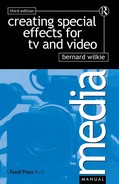Mirrored Effects
It is quite feasible to use conventional mirrors for effects work, but they do have double reflection characteristics that sometimes mar the picture. The effect is often seen where white letters are shown on a black background or where a bright spot of light is seen via a mirror. The front and back surfaces of the glass then throw their own separate reflections. For results that have to be optically perfect, surface-silvered mirrors should be used.
Extending the picture
Mirrors may be used to give added dimensions to small sets, creating the impression that there is far more space than there really is. Large back projection mirrors are sometimes used in this context. A fact that is sometimes overlooked is that there is often more free space between floor and ceiling than between walls of sets. This means that a mirror placed outside a window or porthole can provide a better ‘distant vista’ than could be obtained by a simple, flat painting. For example, a ‘moonscape’ built as a model and suspended in a vertical position above the mirror gives a very realistic panorama seen from the window of a ‘space-shuttle’.
Changing direction
Mirrors may also be used for changing the direction or position of things without this being apparent on the screen. A ball dropped from the ceiling viewed in a mirror at 45 degrees to the vertical appears to be travelling toward the camera lens along a straight, horizontal path. A model space ship or missile similarly dropped appears to be in level flight (and without the encumbrance of nylon lines or wires).
An alien monster can shoot huge coiled tentacles out toward the viewer with unerring aim when this mirror technique is used.
Calculating reflecting angles
There is a simple method of working out the angles of reflection. It consists of drawing an angle on a piece of paper which is then cut out and laid on a diagram of the arrangement required. For example, to calculate the position and size of mirror for a back projection layout the horizontal angle of the lens must be drawn on paper and cut out as a narrow triangle. Laid over a plan of the screen so that the outer lines touch the edges of the screen the paper can now be folded anywhere along its length to show where the projector may be situated and where the mirror should be. It also shows the angle for the mirror and its horizontal width. This technique may be used for all mirror calculations including the design of periscopes and similar optical devices.
MIRRORED EFFECTS
1. Space saving
Where space is limited, scenes may be extended by using mirrors. In this example a model fastened to the back of a flat (a) appears to be on level ground outside the window (b).
2. Calculating angles
A triangular piece of paper (c) representing the angle-of-view can be folded anywhere along its length to demonstrate the angles of reflection. Folded as shown here it indicates not only the angles of the mirrors but also their sizes to see picture (a) from viewpoint (b).

